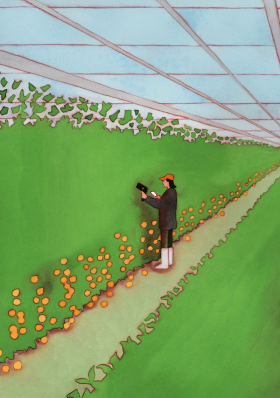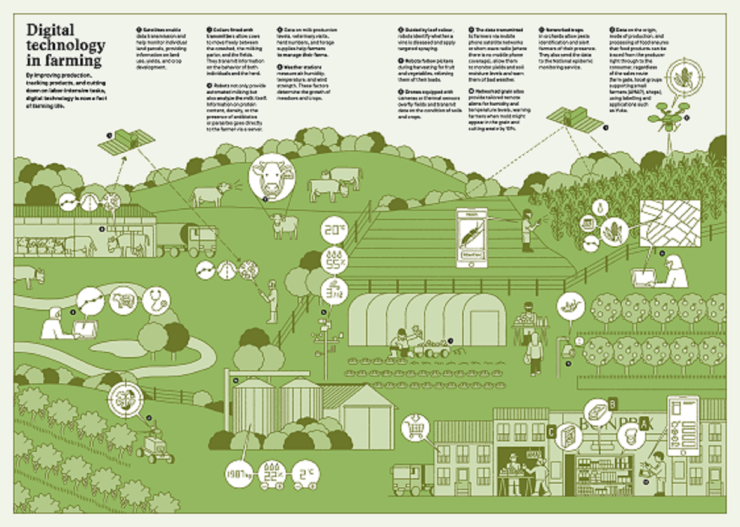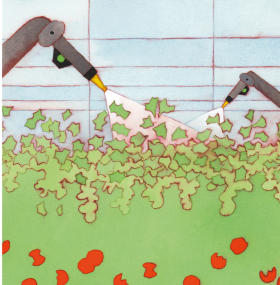Ressources dossier
AgroecologyDigital: a force for farming
Published on 05 April 2023

Farmers are producers who must contend with the hazards of climate change and the living world, but they are also managers and traders, and their success has always relied on tools. Beyond the development of farm machinery and the inseparable bond between farmers and their tractors, the systematic introduction of chemicals in the last century helped farmers to increase production. It has freed them from some of the more onerous farmwork. From the 1980s, digital technology arrived on farms, with bioinformatics and new tools for the selection of varieties and breeds and the development of robots for tasks such as milking. In the past decade, though, these technologies have visibly changed what farming looks like. Sensors act as extra eyes and ears for farmers, improving our understanding of agroecosystems. The knowledge they provide, once processed, has led to the development of programmes to aid on-farm decision making (DSS, decision support systems). Directing the correct quantities of water, fertilisers or phytosanitary products to an exact location and at the right moment calls for great precision. Robots and automated systems are now available to perform these tasks. Digital systems and tools not only improve productivity, they can also reduce the environmental impacts of farming systems. Enhanced by artificial intelligence, they are currently widely used in precision agriculture to improve economic performance and achieve sustainable intensification.
Robots that milk, hoe, weed, sow and spray

Click on the image to download the infographic in PDF.
Initially developed for use in livestock buildings, agricultural robots are capable of performing a variety of tasks (milking, feeding, cleaning out stalls). The first to appear on farms, in 1992, were the milking systems that have now become a standard feature in 70% of new milking parlours; now bringing the rate of global equipment of milking parlours to 10% (approximatively 10,000 robots).
Currently, the major challenge for robotics in agriculture is the use of robots out in the fields. Despite the strides made in the development of robotics in industrial settings, the adaptability and navigational sophistication needed to negotiate conditions in the field can indeed be difficult to develop. It is no easy task to coax these “indoor robots ” to function on uneven and dusty ground, threatened by increasingly unpredictable climate conditions. Back in 2014, INRAE (then Irstea) exhibited a “Follow-Me” robot from its Baudet-Rob project at the SIMA (International Exhibition of Solutions and Technologies for Efficient and Sustainable Agriculture, simaonline.com). This uses Lidar to follow the farmer in the fields, enabling vegetable growers or fruit pickers to harvest a crop without having to carry it. Since then, a further project funded by the ANR (the French agency funding scientific research), the Adap2E project1, has shown even greater ambition. A research prototype is being developed. It can perform different robotic tasks: mapping a field, treating crops, weeding, sowing and spraying. This robot can interpret the data it captures, meaning that it can adapt its actions to the condition of the crop it is observing, and can make adjustments in the task it has been programmed to perform. It can identify priority zones for treatment and is able to act in real time. It is currently being trialled for the spraying of phytosanitary products in vineyards.
The leading global manufacturer of agricultural robots, the French company Naïo, is now democratising access to its products with a price list that starts at €25,000 and the offer of rental schemes. Oz, Orio, Ted and Jo can perform tasks unsupervised. Depending on the model, they hoe, weed, plough, drill or carry payloads. Their purchase by cooperatives is further expanding access and we have reached the point where the investment is worth it because of the savings on labour costs. In France, in 2021, several hundreds of robots were in use, mainly in fruit and vegetable production and in vineyards. Of these, 60% are used in organic farming.
1. Adap2E (Adaptive Autonomous Production Platform for the Environment) is an ANR Young Researchers project run by the TSCF research unit with the help of the ITAP joint research unit.
Upping data quantities to refine model qualities

The systems involved in agriculture are highly complex and there is still much to learn about their various components (plants, animals, microorganisms) and the processes associated with them (hydrological flows, nutrient transformation). We have also seen an explosion in farm sizes since the Second World War. The need to monitor increasingly large tracts of agricultural land and manage large herds places increasing demands on time for an ever-diminishing population of farmers, time that they don’t have to spare. Fortunately, a constellation of different sensors is now available to help the busy farmer. These can be static, installed in camera traps, connected objects and weather stations, fixed to farm machinery or attached to animals, humans or implements, or they can operate as movement detectors or GPS devices, transmitting data flows that are stored and processed using computer calculations or algorithms. Once processed, these data become a form of knowledge that can help to improve our understanding of the systems they monitor. Sensors make the invisible visible, transmitting ever greater detail. They provide the data for models of plant growth or animal behaviours, for example, breathing life into programmes that can not only detect and predict, but also recommend courses of action. The earliest DSS, tools that use modelling to support decision making began to appear in the 1980s.
Providing a valuable service for farm management, digital tools can detect water stress or certain diseases, or can assess carbon or nitrogen concentrations in the soil. They can advise farmers on cropping plans, treatments, weeding, or where to target irrigation. Some of the programmes created by INRAE serve as reference systems, for example those dealing with pests, or Optirrig, an irrigation management programme. Many other programmes have also been developed by Agricultural Technology Institutes to supply the needs of farmers.
More recently, a new generation of decision support systems is making use of remote sensing, via satellites, GPS or the internet, to add even greater detail to the data provided. Drone images are now also available to replace or supplement the data from satellite images.
With digital technology, the invisible becomes visible, more and more precisely.
Hiphen, a start-up that provides plant phenotyping, was incubated by the EMMAH joint research unit at INRAE’s Provence-Alpes-Côte-d’Azur centre. It uses a variety of digital technologies to generate crop imaging, working with networked sensors, drones and satellites whose data can be accessed via a smartphone. These tools can offer unrivalled efficiencies. For tests on wheat, for example, the analysis of images captured from the experimental plots has superseded the painstaking tasks of tallying ears of wheat and taking careful measurements to calculate leaf areas. This work was previously carried out by hand.
Modelling, too, has to change if it is to accommodate the multi-objective nature of farming. What is more, its designers must tread delicately, seeking to aid decision-making without necessarily replacing the decision-maker, supplying the user with information for various purposes: diagnosis, prediction or alerts. To its key role in DSS can be added the help it provides in collective decision-making and training.
The AI powerhouse
With the advent of Big Data, new processing technologies have been developed. Artificial intelligence now allows us to produce original knowledge from vast quantities of data.
With the advent of Big Data, new processing technologies have been developed. Artificial intelligence (AI) now allows us to produce original knowledge from vast quantities of data. These data, harvested in sufficient quantities to encompass a given range of possibilities, are cleaned and processed to predict values and generate classifications, or simply to establish patterns. Deep Learning and Machine Learning technologies are used to process complex images, satellite images, or temporal series (for example, the continuous or repeated measurements of a given parameter over a long period). Data mining techniques are used to extract information from internet data. For example, the Padi-web platform, created by the European MOOD project and developed at the TETIS joint research unit, uses data mining techniques on materials posted on the internet and social networks (Facebook, Twitter) for the early detection of the emergence of animal diseases.
A key goal for researchers is also to ensure that this new knowledge is both accessible and usable, and they do so through their work on vocabularies and the semantic web in particular.
These technologies make it possible to tailor data collection to suit a particular user or purpose, even when they operate on a large scale.
Connecting people
Exchanges between producers, processors, distributors and consumers throughout the food supply sector now occur at a faster pace and, increasingly, in virtual form. Connectivity and information systems permeate the industry’s activities, including logistics.
Farmers in France are big technology fans and internet users. In 2022, 98% of farmers own a computer, and 80% have a smartphone. They go online at least once a day to access information, mostly on the weather but also on new practices and technologies or to check the markets. Experienced users of social networking sites, YouTube, Facebook and WhatsApp in particular, farmers are members of multiple communities, using the latter for individual exchanges of information or to add data to shared information systems (on the weather or parasite levels, for example). Notably, 31% say that they have superfast connections. Some of them reach out beyond their professional interest groups to share their lives on Twitter and other networks, explaining their work on the farm and the challenges they face to a wider audience and offering a portrait of their profession that is both unvarnished and positive.
Farmers in France are big technology fans and internet users. In 2022, 98% of farmers own a computer, and 80% have a smartphone.
In a sector that expanded rapidly with lockdown, food distribution platforms operate at very different scales. While they may be owned by national distributors such as Grand Frais, a new and rapidly expanding player, initiatives at a more local level, driven by both individuals and groups, have also brought consumers and producers closer together. La Ruche qui dit Oui, for example, a network of local distribution hubs for neighbouring producers and customers, has now taken on all the trappings of a start-up, having very quickly grown its operations and sales figures, while numerous “fresh and local” initiatives have sprung up, driven by local communities who have been encouraged by the EGalim 2 Act to participate in the national move towards local food. Having observed the growth of these platforms during successive lockdowns, the ObSAT Observatory2, run by the Alimentation Locale (local food) joint technological network (RMT), nevertheless notes that many of them have more recently seen a downturn in profits, often brought about by hastily devised business plans that have not been thought through.
In today’s world, there is a place for digital technology on all types of farm, whether conventional, organic, large or small, although it has historically been the larger intensive agricultural players who have benefited most. Reaching beyond agricultural practices and individual performance, digital makes new data available to value chains and brings greater ease of connection. In doing so, it is shifting the sector’s dynamics of power and the patterns within the food value chain, offering a way to close the social gap in access to information.
2. The Alimentation Locale joint technological network (RMT), which INRAE co-organises, created ObSAT, the observatory for local food systems, working with the Brittany CIVAMs, a federation of centres set up to promote and valorise farming and the countryside.
-
Aliette Maillard
(Send email)
Author / translated by Teresa Bridgeman
-
Sophie Nicaud
Author / translated by Teresa Bridgeman
-
Philippe Fontaine
Author / translated by Teresa Bridgeman
-
Nicole Ladet
Author / translated by Teresa Bridgeman
